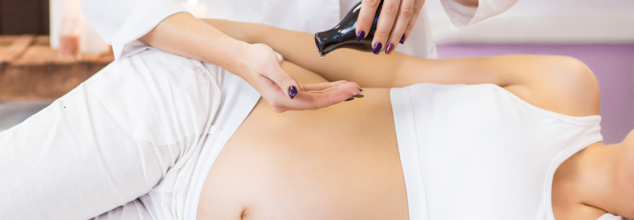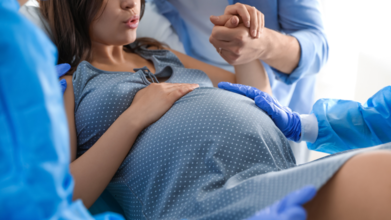- Health Conditions A-Z
- Health & Wellness
- Nutrition
- Fitness
- Health News
- Ayurveda
- Videos
- Medicine A-Z
- Parenting
- Web Stories
Is It Safe To Use Bio-Oil During Pregnancy?

Bio-Oil For Pregnancy (Credit-Canva)
Bio-oil is a popular skincare product that claims to improve the appearance of scars, stretch marks, uneven skin tone, and dehydration. It's a blend of plant-based oils, vitamins, and minerals. These ingredients work together to hydrate the skin, reduce inflammation, and promote skin cell turnover. Many pregnant women use bio-oil to help with the stretchmarks that come along with growing a human being in your body. But many people have questioned the validity of it and whether it is okay for pregnant women to use.
Is Bio-Oil Safe During Pregnancy?
While many pregnant women turn to Bio-Oil to help prevent stretch marks, it's important to consider its potential risks. Some experts do not believe it is safe for pregnant women to use because of its content. Here are some things you should keep in mind.
Retinol Content
The original formulation of Bio-Oil contains retinyl palmitate, a form of vitamin A. It has even been classified as a category C product which means that the product shows adverse effects on the fetus but there are no adequate studies in humans to confirm the risk. You may still use it to despite the potential risk. Retinol is known for its exfoliating and anti-aging properties, but it can be harmful to a developing fetus when used topically during pregnancy.
Rosemary Oil
Study on Rosemary tells us that both the original and natural formulations of Bio-Oil contain rosemary oil, which can stimulate uterine contractions. While the amount in skincare products is typically low, it's advisable to consult with a healthcare provider before using products containing rosemary oil during pregnancy, especially in the later stages.
Benefits Of Bio-Oil
While Bio-Oil can be a helpful skincare product for many, it's essential to consult with a healthcare provider before using it during pregnancy. They can provide personalized advice based on your specific needs and concerns. It's also important to choose the appropriate formulation, considering the potential risks associated with certain ingredients.
Despite the potential risks, many pregnant women find Bio-Oil beneficial for their skin. Here are some potential benefits.
Hydration
The oils in Bio-Oil, such as sunflower oil and vitamin E, can help moisturize the skin, reducing dryness and irritation. This is especially important during pregnancy, as hormonal changes can lead to dry, itchy skin.
Reduced Inflammation
Pregnancy can sometimes trigger skin inflammation, leading to redness and discomfort. Bio-Oil's ingredients, such as chamomile and lavender oil, have soothing properties that can help calm irritated skin. These natural oils work to reduce inflammation, providing relief from the itchiness and redness associated with pregnancy-related skin conditions.
Improved Skin Elasticity
As your belly grows during pregnancy, your skin stretches to accommodate the changes. Bio-Oil aims to support your skin's elasticity by keeping it hydrated and supple. This can help reduce the appearance of stretch marks, those unsightly lines that can develop on your skin due to rapid stretching. However, it's important to remember that genetics also plays a significant role in stretch mark formation. While Bio-Oil can help, it's not a guaranteed solution.
Fact Check: Is Giving Birth On Your Back Against Your Body's Natural Anatomy?

Credits: Canva
"I may or may not burst some bubbles with this comment, but what if I told you that your pelvis was in fact not too small and or that your baby's head was in fact not too big?" says Amber Grimmett, a US-based Pregnancy and
Postpartum Coach. In her post, she also writes that the position most women give birth in, also called the lithotomy position or lying on your back is "against your body's natural birth mechanics". In a video she posted on her Instagram @fierce.not.fragile, she talks about pelvis and baby's head size, explaining how the birthing position that has been made standard may not be right.
She says that when the mother lies flat on her back with knees wide, her tailbone cannot move freely and the pelvic outlet, the space baby needs to exit, "literally closes off".
This, she says, creates a domino effect. Then comes longer labors, more interventions, and higher risk of pelvic floor dysfunction. "Your body was designed to birth, but not in positions that fight against its natural design," she writes.
What Does Science say?
We did a fact check on her claim and here's what we found.
For most women in the United States today, giving birth means lying on a bed, feet in stirrups, and being told when and how to push. But mounting research, including a 2014 study published in The Journal of Perinatal Education, titled, 'Healthy Birth Practice #5: Avoid Giving Birth on Your Back and Follow Your Body’s Urge to Push' suggests this common practice, known as the supine or lithotomy position—might not actually be the safest or most effective way to bring a baby into the world.
How Birth Ended Up on Its Back
For centuries, women birthed in positions that worked with gravity, standing, squatting, sitting, or even using stools or ropes for leverage. These upright positions made physiological sense: gravity helped the baby descend, shortened labor, and reduced maternal fatigue.
Then came King Louis XIV of France. Fascinated by childbirth, he reportedly preferred to watch his mistresses deliver, and lying flat gave him the best view. The practice caught on among European aristocracy and eventually spread widely.
By the early 1900s, births had largely moved from homes to hospitals. Doctors saw childbirth less as a natural process and more as a medical procedure. Putting women on their backs gave physicians easier access for interventions such as forceps delivery, anesthesia, and continuous fetal monitoring. Convenience for the doctor—not necessarily benefit for the mother or baby, became the standard.
The Problem with the Supine Position
Research over the past three decades has consistently shown that giving birth lying flat has no clear benefits for either mother or baby. In fact, there are multiple disadvantages:
- Longer Labor: When women lie flat, the baby must work against gravity, which can slow descent.
- Narrower Pelvis: The supine position can actually reduce pelvic diameter, making delivery more difficult.
- Increased Risk of Interventions: Supine births are linked with more use of forceps, vacuum deliveries, and episiotomies.
- Reduced Blood Flow: Lying on the back can compress major blood vessels behind the uterus, reducing blood flow to the baby.
- More Perineal Trauma: Directed, forceful pushing while on the back is associated with more tears and a weakened pelvic floor, raising the risk of urinary incontinence later.
Despite this, U.S. survey data shows that nearly 70% of births still happen in supine or lithotomy positions, with fewer than 10% of women using traditional squatting, standing, or side-lying positions.
The Case for Upright and Spontaneous Pushing
Standing, kneeling, and squatting use gravity to help the baby descend and can even widen the pelvic outlet, giving more room for delivery. Even side-lying, which is gravity-neutral, has been shown to reduce perineal tearing.
Equally important is how women push. Many hospitals still direct women to push forcefully for long periods, holding their breath. But evidence shows that spontaneous, self-directed pushing—where the woman follows her own urge, improves oxygenation, reduces maternal stress, and lowers the risk of fetal distress.
In fact, research has found that directed pushing only shortens labor by about 13 minutes on average, a difference not considered clinically significant but one that may come at the cost of pelvic floor damage.
Rethinking Hospital Policies
Some hospitals have strict time limits on how long the second stage of labor (pushing phase) can last before recommending interventions such as a C-section, even if there are no signs of danger for mother or baby. Recent guidelines from the American College of Obstetricians and Gynecologists (ACOG) now acknowledge that the second stage can safely last much longer, up to five hours for first-time mothers with an epidural.
However, there is little emphasis on letting women move freely, change positions, or delay pushing until their natural urge returns. This gap between research and practice persists, though midwives and doulas are often more supportive of these evidence-based approaches.
Your Children Are Not At Fault For Being Lazy, You Are: Study Finds The Effect Of Inactive Parents On Children

(Credit- Canva)
Getting children to be active and socialize is a big part of parenting. Even kids, no matter how energetic they are, like lazing around and relaxing. However, this habit can catch on quick, but they are not entirely at fault for it.
A new study has found a strong connection between what parents do and how active their kids are. It turns out that children are more likely to be "couch potatoes" or full of energy based on what they see their moms and dads doing every day.
In a study published in the journal Sports Medicine and Health Science. Researchers showed that when parents have an active routine, their children are less likely to sit still for long periods. The study followed 182 kids and their parents for a week and found that children of inactive parents were more sedentary, while those with active parents were more active themselves.
Do Mothers Influence Their Kids More Than Fathers?
Interestingly, the study discovered that mothers have more than twice the influence of fathers on their children's physical activity. This finding held true even when the researchers considered other things like the family’s income or the child’s age. The experts believe that active parents not only know how important exercise is but also actively encourage their kids. They might be more likely to limit screen time and support activity by taking their children to the park, buying sports equipment, or setting up games in the backyard.
How Can We Encourage Kids to Be More Active?
While a lack of time or safe places to play can make it hard for kids to be active, this study highlights how important a parent's example is. The results suggest that by promoting active habits within families, we can improve the health of the next generation. The researchers believe these findings can be used to create public campaigns and policies that encourage families to live a more active lifestyle together.
How Can Lack Of Activity in Children Affect Their Health?
According to the American Heart Association, physical activity is vital for everyone, but it’s especially important for helping children grow into healthy adults. They suggests that kids and teens (ages 6–17) should get at least 60 minutes of moderate to vigorous physical activity every day. In a world full of digital distractions, it can be a challenge to get kids moving, but teaching them healthy habits now can set them up for a lifetime of well-being.
Kids are naturally active, but they often become less so as they get older, especially girls. If your child's interests change, that's okay—the key is to help them find a new activity they enjoy.
- Be active yourself and find ways to get the whole family moving together.
- Encourage your kids to choose activities they genuinely like. Don't use physical activity as a form of punishment.
- Reduce the amount of time they spend on devices, watching TV, or playing video games.
- Give them toys and equipment like bikes, skateboards, and balls.
- Encourage them to join sports or other activities like dance or swimming. Explore local parks, pools, and bike paths.
- If your child is currently inactive, begin with small, gradual steps to avoid injury or discouragement.
- Reward and encourage your kids for their efforts to help them stay motivated.
An Urge To Push, She Thought It Was Food Poisoning, She Went to the Bathroom And Came Out With A Newborn

Credits: Michael Green/ SWNS
Imagine going to bed after a long road trip and waking up in the middle of the night with what feels like food poisoning, only to find yourself giving birth in a hotel bathroom.
That’s exactly what happened to Helen Green, 45, during a family vacation in Toronto, Canada. Helen had no baby bump, no missed periods, no morning sickness, nothing to suggest she was pregnant. But just hours after checking into their Holiday Inn room, Helen suddenly felt the urge to push.
“I had no idea what was happening, my body just took over,” she said, as the New York Post reports. After two intense pushes, she gave birth right there in the bathroom, delivering a healthy baby girl, Olivia, into her own arms.
Her husband, Michael, woke up to the sound of a crying newborn.
When Pregnancy Hides: The Reality of Cryptic Pregnancies
Helen’s experience is not just rare, it’s medically recognized. She had what doctors call a cryptic pregnancy (sometimes called a stealth pregnancy).
A cryptic pregnancy is when a person doesn’t realize they are pregnant until very late in the pregnancy, or, in some cases, until labor starts.
While most people find out they are pregnant between 4–12 weeks, usually after missing a period, cryptic pregnancies go unnoticed because there are no obvious symptoms, or the symptoms are mistaken for something else (stress, perimenopause, food issues, etc.).
Experts estimate that about 1 in 475 pregnancies go undetected until 20 weeks, and about 1 in 2,500 remain hidden until delivery, just like Helen’s.
Why It Happens
There are several medical and hormonal reasons why a pregnancy can go undetected:
Perimenopause or PCOS: Irregular cycles can mask a missed period.
Recent childbirth: If you’re still breastfeeding, ovulation can be unpredictable, leading you to believe you can’t get pregnant.
Birth control use: Even with perfect use, there’s still a chance of pregnancy, which can make symptoms easy to dismiss.
False negatives on pregnancy tests: Rare, but possible if taken too early or incorrectly.
No pregnancy symptoms: Some people simply don’t experience nausea, breast tenderness, or weight gain.
A Medical and Emotional Shock
For Helen, the shock was doubled by her history, she had experienced multiple miscarriages after the birth of her first daughter and believed she was entering perimenopause.
“I worked, exercised, wore the same clothes and ate the same food as usual,” she said. “Even the doctors at the hospital were surprised.”
Listen to Your Body
Cryptic pregnancies are rare, but they highlight an important health message: never ignore sudden, unexplained changes in your body.
If you’re experiencing unusual bleeding, bloating, weight changes, or persistent fatigue, especially if you’re in perimenopause or on birth control, it’s worth talking to a healthcare provider and getting tested.
Because as shocking as Helen’s story sounds, it’s a reminder that pregnancy can still surprise you, even at 45, even without symptoms, and even on vacation.
© 2024 Bennett, Coleman & Company Limited

